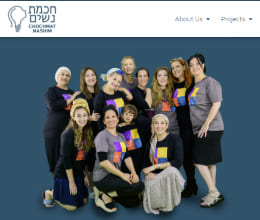When Adina Sash, aka “Flatbush Girl,” called for a “sex strike” to help free Malky, a 29-year-old woman who has been chained to a dead marriage for four years with no hope for a divorce in sight, the big news was the idea of the strike. Malky is locked in the marriage not only by her husband, Volvy, and his family, but by the community that does not demand her freedom, even as it allows her husband all communal rights. Full disclosure: five different rabbinic courts have given orders that Volvy be ostracized until he gives Malky a get, but that hasn’t gotten in the way of his participation in the community.
Within moments — or so it seemed — and for the next week or so, rabbis took to social media to make statements against Sash’s initiative, podcasters lambasted her, and even Rabbi Herschel Schachter, preeminent rosh yeshiva at Yeshiva University who usually reserves his opinions for behind the scenes, weighed in against this plan. The claim against the strike was that it could destroy marriages by using intimacy as a weapon.
Frankly, I’m pained that so many rabbis in positions of leadership in the Orthodox world went public with shock and dismay at women choosing a sex strike to spotlight the plight of a woman chained in marriage when they rarely express public shock or dismay for the many women chained in Jewish marriage.
It should not take “sex” to raise public rabbinic statements about women chained in marriage.
But I am not surprised. Over the 12 years that I have worked to free agunot, this has been my experience. Many women await their divorces for years, while they are stuck in endless cycles of negotiations (read: extortion) for their freedom. Some are dragged from court to court, or spend years waiting for court dates to which the husband does not show up. In most cases, the women wait and wait — and are still agunot.
Ironically, it is only when women take matters into their own hands and use their own agency that anything really shifts in the establishment.
In some cases, women decided they were not waiting any longer. After years of pleading for their freedom, of begging the courts to investigate ways to void their marriages, with no success, they began to walk away. In pain and betrayal, they chose to move on with their lives, outside of the system of Jewish law that let them down, and they began dating.
Lo and behold, as it became known that the women were moving on with their lives, the rabbis turned to those halachic solutions that they had previously declined to use.
Suddenly, the processes were viable. Suddenly, they did look into the marriages (often discovering a history of abuse and even deceit, which under certain criteria establishes the voiding of the marriage). And those same rabbis who had been content to let women live their lives alone managed to find halachic reasoning to free them.
I am not (yet) advocating for agunot to begin dating — nor I am even advocating that they tell the rabbinic courts that they are doing so, as one woman I know did so that the court would exert pressure on her husband for a divorce (it worked).
Rather, I am proposing something else. It is time to decide that ours will be the last generation of agunot, that our daughters will be safe. And it is up to us to make it happen — because salvation isn’t coming top down.
I do not want to discount the importance of rabbinic leadership in the Orthodox Jewish community and with regard to freeing agunot especially. For the most part, rabbis have dedicated their lives to their communities and believe in the sanctity of Jewish law. Turning to them to free agunot makes sense.
And I have tried. For years. I have written. I have spoken. I have begged.
And I have given up.
It was one rabbi in particular who broke my faith in “the establishment.” Enough time has passed that I can write about it here, but I was crushed.
I asked a particular rabbi, who is considered an authority by many in the Orthodox world (I cannot name him, as our meeting was off-the-record) to help me and the others I work with to make this the last generation of agunot. I explained how I wanted to bring dignity back to Jewish marriage and divorce.
He responded by telling me the following story:
A young woman came to him after a few weeks of marriage, saying that her husband would not consummate the marriage and was apparently homosexual. It was discovered that the young man had been gay in high school, and that he had not shared that fact with the young woman. She asked to be freed from the marriage.
(A lack of consummation over time due to undisclosed homosexuality is often treated by the rabbis as grounds not for divorce, which is not necessary, but for declaring the marriage invalid to begin with.)
Instead of relying on this halachic reasoning, the rabbi consulted with three therapists as to whether it is possible for a man to have been gay, then for him to have stopped being gay, and then for him to be gay again (interpreting the young man’s homosexual journey since high school).
One of the three therapists said that what the rabbi had posited was possible, and, on that basis, the rabbi decreed that the man could have been heterosexual on the day of the marriage, thus making it valid.
The young woman was locked into a sexless, loveless marriage for years — even bearing the young man’s children (I believe through IVF). Eventually, she paid her husband $50,000 to entice him to divorce her, so she could be free of him and the sham marriage.
I asked the rabbi why he had left the young woman in this terrible situation. He told me: “We don’t end Jewish marriage so quickly.” Devastated, I replied: “This, you call Jewish marriage?!”
He was proud of what he had done. He felt he had kept a Jewish marriage together, while I felt my last hope in the rabbinic establishment shatter my heart.
In that moment, I understood: to the establishment, women’s happiness, fulfillment, and dignity are subservient to an ideal of marriage that depends on women but does not consider them. Since then, I have encountered far too many stories that demonstrate that this rabbi is not alone in his approach.
Like the story of a woman whose husband hit her in the “yichud” room (the couple’s seclusion after the chuppah). She left the room and went straight to her parents. She never went home with the man, and the wedding was never consummated. She never needed a get, as the marriage was not completed and he had hid his abusive nature. Three rabbinic judges supported her and wrote her the legal decision (p’sak din) to free her, but her community rabbis did not accept the judges’ decision, insisting that she needed a get. Five years later, she paid the husband off and received a get.
How is this Jewish marriage?
Traditionally, Jewish law has pushed rabbis to be lenient when it comes to unchaining agunot, and to diminishing the risk of agunot. Unfortunately, that principle is too often shunted aside in our own day. But famous rabbis in history would be appalled: Rabbenu Tam (1100-1171) said: “Whoever acts stringently in the matter (agunot) is nothing but a sinner.” Around half a century later, Maharam Alashkar (1466-1542) presents the same aspersions in a more vivid way: “One who fosters ‘iggun’ and forbids a woman to marry and is stringent, of him the verse states: ‘His donkey will instruct him.’” Classical agunot were tied to husbands whose whereabouts were unknown, not because the husbands refused to divorce their wives. But the rebuke at chaining a woman to an impossible marriage is the same.
People claim that prenups prevent agunot. No doubt, they do, to some large extent — and in that way, they are a wonderful addition to the toolbox (everyone should sign one!). However, they are not used universally, which diminishes the protection they offer, and they are not foolproof. For anyone with enough money, hubris, and the ability to disappear, the document can be ignored and the spouse trapped.
So what do I suggest? How can the Jewish community help those who are trapped right now, unable to move on, to live as Jewish women? How can we make this the last generation of agunot?
- Every couple must sign a halachic pre- or post-nup agreement.
- Batei Din (rabbinic courts) that oversee couples’ divorces must wait no more than six months to establish that the divorce is truly desired (by either party), and then issue a seruv (the court’s declaration that one party has not met with the requirement to appear in court). Likewise, they must forbid people to “court-hop,” which pushes off the delivery of the get. No more game-playing.
- No extortion. Women’s freedom cannot be for sale.
- NO tolerance for get-refusal. No refuser should be allowed to walk into a shul, let alone pray there or enjoy “honors,” such as being called to the Torah for an aliyah. Enforce the seruv!
- Finally, if a year has passed from the request to divorce and one party still refuses to proceed, the court must use halachic tools to investigate whether the the marriage was invalid to begin with — a process that itself exerts pressure on the rabbis and the husband to make sure a get is given (even if it might not be necessary).
Steps 1 – 4 would prevent (in my estimation) 80 percent of get-refusal. For the last 20%, Step 5 must come into play.
In the worst cases of get-refusal, after trying (and often succeeding) to achieve a freely given get, rabbis “turn it and turn it,” as the Hebrew idiom goes, to dig into millennia-old sources on voiding marriages until they find a solution. The rabbis may determine that the witnesses to the wedding were invalid, deceit was employed, hidden significant defects, abuse, ownership of the ring used, etc. They then issue a “p’sak din” — a halachic determination that the marriage was never a marriage. No divorce is needed, no get to be given. But often, these measures lead the man to give a get that will be widely accepted, and then both parties can (and should) separate and go on with their lives.
The community has not always accepted these decisions, as in the story above. But at a grass-roots level, we can and should accept the halachic decisions — those “piskei din” — given to women by honorable, seriously religious rabbis who know Jewish law.
Women who find themselves in this position need to know that we will accept them. They need to know: We will become their community. We will dance at their weddings. We will accept the children from their future husbands as full-fledged Jewish children, and not mamzerim (children born from an illicit union)! For there is nothing illicit about their relationships — to the contrary, it is their previous liaison that is rejected as never-a-marriage.
If we do this together, then a systemic solution that will end the agunah crisis and the mockery of Jewish marriage is just around the corner.
It is time for us to take stand.
Original Published On The Times of Israel


